Table of contents
The date variety Deglet Nour, also Deglet Noor ( Phoenix dactylifera) is one of more than 400 date varieties. It is the best date variety for replacing sugar in baked goods.
Use in the kitchen
Practically all dates outside the production areas are dried and are considered dried fruit. But few dates are of raw food quality, as they often undergo a heating process to ensure a longer shelf life.
Deglet Nour dates are four to six centimeters long and contain firm and juicy flesh. They have a honey-like flavor and taste slightly like caramel. Medjool dates are also popular, which are characterized by their size and thick, juicy-sweet flesh and are ideal for stuffing.
Deglet Noor dates taste great on their own as a snack. They can also be used to make different types of 'energy balls', such as date-walnut balls or almond-date balls with cinnamon and ginger. These consist of pureed dates that are mixed with all kinds of nuts and other ingredients and then formed into small balls. They are a delicious snack for in between meals. Sliced dates are an excellent topping for muesli ( pea muesli), salads or soups.
Blended dates or date syrup are a good substitute for refined sugar, for example in a raw chocolate spread or in raw ketchup made from dried tomatoes. Chopped dates can also be used in a range of desserts and pastries. Dates can also be used to make savoury dishes, such as a date sauce that goes well with wraps or salads. In Arabic cuisine, dates are valued as fillings in sweet pastries and in the famous North African tagine, the mixed stew that wonderfully combines vegetables, meat and dried fruit.
Vegan recipe for pumpkin slices with dates
Ingredients (for 4 people): 4 cloves of garlic, 600 g pumpkin, 1 tbsp rapeseed oil, 1 tsp cayenne pepper, 1 tsp sumac, 6 dates, salt.
Preparation: Cut the garlic into thin slices. Cut the pumpkin into bite-sized slices. Fry the pumpkin and garlic in oil and season with cayenne pepper and sumac. Pit the dates and cut into strips. Add to the pumpkin and fry briefly. Season with salt. Serve the pumpkin lukewarm or cold.
Vegan recipes with Deglet Nour dates can be found under the note: " Recipes that have the most of this ingredient ".
| Not only vegans or vegetarians should read this: Vegans often eat unhealthily. Avoidable nutritional errors. |
Purchasing - Storage
Major retailers such as Coop, Migros, Denner, Volg, Spar, Aldi, Lidl, Rewe, Edeka, Hofer, Billa stock Deglet Nour dates, some of which are organic. The dates are also available in health food stores, online shops, or organic supermarkets such as Denn's Biomarkt and Alnatura. Prefer natural, organically produced dates and make sure they do not contain any additives.
The harvest time for Deglet Nour dates is mainly from August to October. Dates can be stored for several months, so they are available all year round, but with a reduction in quality, especially if not stored properly. Where can you buy fresh dates? Fresh dates of excellent quality can be ordered from specialised online shops. Wholesalers usually sell bulk goods that can be stored for longer.
Are dates raw? If you care about raw food quality, you should only buy products with the appropriate label in a trusted store, or find out more about it beforehand. Raw dates are gently dried and not treated. This means they are not pasteurized, gassed, frozen or treated with sugar, oil or flour dust. Any sulphurization is indicated on the packaging with the addition of either "E220" or "sulphurized".
The availability of Deglet Noor dates varies depending on the size of the store, catchment area, etc. If you are interested, click on our recorded food prices for the DA-CH countries (above under the ingredient image). There you will find current prices from various supermarkets and their price development.
Storage tips
Packaged Deglet Nour dates (not pitted) can be stored in the dark at room temperature for one to two years. They dry out easily and the sugar can crystallize, which reduces the quality. Older dates are good for baking. Once the package is opened, it should be stored airtight and protected from light. Storing in the refrigerator is the best way to preserve freshness.
Ingredients - Nutritional values - Calories
Deglet Nour dates (organic) have an energy content of 282 kcal. 100 g contain 75 g of carbohydrates, of which 63 g are sugar. This means they are very high in sugar (70.4% of the daily requirement). Therefore, you should only eat a few dates per day. 5-6 dates (approx. 50 g) contain 35.2% of the daily intake of sugar.
They contain plenty of fiber. The 8.0 g/100g of dietary fiber corresponds to 32.0% of the daily fiber requirement. Their fat content is only 0.39 g/100g. The protein content is also low at 2.4 g/100g. 1
Deglet-Nour dates are rich in potassium. They contain 656 mg per 100 g, which is 33% of the daily requirement. Bananas, which are often cited as a good source of potassium, contain 358 mg/100 g, which is 18.0% of the daily requirement. Dried porcini mushrooms contain a lot of potassium (2000 mg/100g). 1
They also contain small amounts of copper, manganese and magnesium, as well as small amounts of folate (folic acid), phosphorus and iron. 1
Dates contain few vitamins. They contain small amounts of vitamin B6, pantothenic acid (vitamin B5) and niacin (vitamin B3). Contrary to "advertising promises", they only contain traces of vitamin A and vitamin C. 1
The complete ingredients of Deglet Nour dates, the coverage of the daily requirement and comparison values with other ingredients can be found in our nutrient tables below the ingredient image.
Health effects
Dates are rich in polyphenols, carotenoids, tannins and flavonoids, which are known to be powerful antioxidants. Antioxidants reduce the risk of chronic diseases (e.g. cardiovascular disease, cancer and diabetes) and promote general health and well-being. 11 Numerous phenolic compounds also have antibacterial effects due to their oxidizing potential 11,17, which is why date syrup is used for colds, sore throats and coughs. 17
Are Deglet Nour dates healthy? Deglet Nour is a type of date with a high fiber content (8.0 g/100g). 1 Fiber is responsible for a healthy digestive system 14, has a positive effect on blood sugar levels when eating carbohydrates and starchy foods and can thus reduce the risk of type 2 diabetes 15. A diet rich in fiber leads to a feeling of satiety for longer, which can help with weight loss. 16
Several studies show that eating dates during the last weeks of pregnancy and during labor can shorten labor. Dates also promote dilation of the cervix and reduce the likelihood of needing labor induction drugs. The tannins contained in dates also promote contraction of the smooth muscles of the cervix. 18,19 This is attributed to the fact that dates are optimal energy sources with high glucose content. However, further studies are needed to understand the positive effect of dates on the birth process in more detail.
Dangers - Intolerances - Side effects
While there are many studies on the allergic potential of date pollen, those on the date fruit are still rare. Studies from Saudi Arabia show that date fruits can trigger allergic reactions. However, the test subjects did not react in the same way to every variety. 6,7
Dates are very high in sugar and fructose. People with fructose intolerance or sensitivity should avoid dates. 13
Folk medicine - natural medicine
Dates are also traditionally administered to relieve fever, liver and abdominal pain, cystitis, gonorrhea and edema. Date syrup or paste is used for colds, sore throats and coughs. 10 They are also used for constipation, kidney stones, stomach and intestinal ulcers, postpartum bleeding, among other things. 11 Despite their widespread use, there is only limited scientific and clinical evidence to support the above-mentioned uses.
Ecological footprint - animal welfare
The ecological CO 2 footprint of dates depends on the country of origin, the corresponding transport and the method of consumption, but is roughly estimated at 0.6 kg CO 2 eq/kg. 20 Fresh dates, for example, require cooling during transport and are heavier - the amount of energy required and the amount of emissions produced are correspondingly higher compared to dried dates. The main causes of emissions from date cultivation are pesticides, nitrogen fertilizers used and motor fuel. 21 However, date palms are particularly efficient at storing carbon, which in turn reduces their ecological footprint. 20
The amount of water required to produce 1 kg of dates is 2277 litres. 22 Since the main growing countries tend to be areas with little rainfall, this amount is considerable and artificial irrigation is sometimes used for irrigation. This also has a negative impact on the ecological footprint. Another major problem in date cultivation is the cultivation method - date palms often grow in monocultures, where they are susceptible to diseases and pests and synthetic pesticides and herbicides are used to prevent these. 20 In a study, measurements were taken of pesticide residues and heavy metal contamination in dates from Iran and found values that were far above the values classified as safe. 23 Ideally, when buying dates, you should buy organically grown goods.
Worldwide occurrence - cultivation
The date is one of the oldest known fruit crops. It has been cultivated in North Africa and the Middle East for at least 5000 years. Due to the long history of date cultivation and the wide distribution and exchange of date varieties, the exact origin (gene center) of the date is not clear. It most likely originates from ancient Mesopotamia (Iraq, Syria) or the West Indies. 8
The date variety Deglet Nour (دقلة نور - Arabic: Finger of Light) originated in Algeria. Today, 90% of production comes from Tunisia and Algeria. Only a small part of the production of 'Algerian dates' takes place in Israel and the USA. 4 According to FAOSTAT, around 9.66 million tons of dates were grown worldwide in 2021 (total production of all date varieties). The main growing areas were Egypt (1.75 million tons), Saudi Arabia (1.57 million tons) and Iran (1.30 million tons). 2
Cultivation - Harvest
The real date palm can reach a height of 15 to 25 m. The date palm is dioecious, meaning that only female or male inflorescences appear per individual. A date plantation has an average economic lifespan of 40 to 50 years, but some date palms are productive for up to 150 years. Depending on the method of propagation, the young date palm needs 3 to 8 years before it bears its first fruit. 8
Date palms are diploid (dioecious), meaning that each individual bears either male or female inflorescences. Fruits only come from pollinated female inflorescences. In commercial cultivation, only a few male palms are grown so that their pollen can be collected and used for artificial pollination of the female date palms. In North Africa and the Middle East, artificial pollination has been practiced for thousands of years. This practice saves a lot of valuable water. 5,8 Palm care and pollination, as well as fruit harvesting, usually take place at high altitudes. In some cases, the fruit clusters are also thinned out to improve the quality of the fruit. Although climbing trees to access the crown is still found in all date-producing areas, the use of mechanical elevators is common in more advanced or industrialized production areas such as the United States. Date harvesting is still done by hand due to the lack of specialized harvesting machines. 8
Industrial production
After harvesting, damaged fruit is sorted out. The dates are washed and then dried with hot air. To remove the stones from the dates, the stem is cut off and the seed is pierced through the flesh with a wide needle. In industrial production, the majority of the products are then gassed and sterilized. Methyl bromide gas or, increasingly, gamma radiation is used for this. 12
The quality of the fruit is improved by hydrating or dehydrating the dates. The moisture content must be below 20% so that the dates can be stored without refrigeration. To do this, the fruit is heated to 60-70 °C. 9,12 The surface is sometimes treated with starch or oil to improve the texture. After pasteurization at 66 °C for 30 minutes, the dates are checked and packaged for shipping. Shipping is mostly carried out under refrigerated conditions. 9,12
Further information
The date palm ( Phoenix dactylifera) is a plant species of the date palm genus ( Phoenix) in the palm family (Arecaceae). Dates are known as the "bread of the desert" due to their high fiber content and are an important food in the growing areas. The exact number of date varieties is unknown (probably around 400). More than 100 varieties of Arabian dates are known. 7 well-known date varieties are: Medjool, Deglet Nour, Khidri dates, Ajwa, Yahidi, Hallawi and Mazafati dates.
Alternative names
The Deglet Nour is also called Deglet Noor.
Bibliography - 22 Sources (Link to the evidence)
| 1. | USDA United States Department of Agriculture. |
| 2. | FAOSTAT Food and Agriculture Organization of the United Nations. Dates (2021). |
| 4. | Liu P, Date varieties, The marketing potential of date palm fruits in the European market. Commodity and Trade Policy Research Working Papers No. 6 (2003). |
| 5. | American botanical council. Date (Phoenix dactylifera, Arecaceae). |
| 6. | Kwaasi AA, Harfi HA, Parhar RS, Al-Sedairy ST, Collison KS, Panzani RC, Al-Mohanna FA. Allergy to date fruits: characterization of antigens and allergens of fruits of the date palm (Phoenix dactylifera L.). Allergy. 1999 Dec;54(12): 1270-7. |
| 7. | Kwaasi AA, Harfi HA, Parhar RS, Collison KS, Al-Sedairy ST, Al-Mohanna FA. Cultivar-specific IgE-epitopes in date (Phoenix dactylifera L.) fruit allergy. Correlation of skin test reactivity and ige-binding properties in selecting date cultivars for allergen standardization. Int Arch Allergy Immunol. 2000 Oct;123(2): 137-44. |
| 8. | Chao CT, Krueger RR. The Date Palm (Phoenix dactylifera L.) Overview of Biology, Uses, and Cultivation. HortScience horts. 2007;42(5): 1077-1082. |
| 9. | Glasner BA, Botes A, Zaid A, Emmens J. Date harvesting, packinghouse management and marketing aspects. In: Zaid A (ed.) Date palm cultivation. Food and Agriculture Organization Plant Production and Protection paper no. 156. Food and Agriculture Organization of the United Nations, Rome, Italy (2002): 177–208. |
| 10. | El Hadrami A, Al-Khayri J. Socioeconomic and traditional importance of date palm. Emir J Food Agric. 2012;24(5): 371-385. |
| 11. | Taleb H, Maddocks SE, Morris RK, Kanekanian AD. Chemical characterisation and the anti-inflammatory, anti-angiogenic and antibacterial properties of date fruit (Phoenix dactylifera L.). J Ethnopharmacol. 2016 Dec 24;194: 457-468. |
| 12. | Ashraf VZ, Hamidi-Esfahani Z. Date and Date Processing: A Review. Food Reviews International. 2011 Feb;27(2): 101-133. |
| 13. | Vayalil PK. Date fruits (Phoenix dactylifera Linn): an emerging medicinal food. Crit Rev Food Sci Nutr. 2012;52(3): 249-71. |
| 14. | Gill SK, Rossi M, Bajka B, Whelan K. Dietary fibre in gastrointestinal health and disease. Nat Rev Gastroenterol Hepatol. 2021 Feb;18(2): 101-116. |
| 15. | Evans CEL. Dietary fibre and cardiovascular health: a review of current evidence and policy. Proc Nutr Soc. Februar 2020;79(1): 61–7. |
| 16. | Miketinas DC, Bray GA, Beyl RA, Ryan DH, Sacks FM, Champagne CM. Fiber intake predicts weight loss and dietary adherence in adults consuming calorie-restricted diets: the pounds lost (Preventing overweight using novel dietary strategies) study. J Nutr. 1. Oktober 2019;149(10): 1742–8. |
| 17. | Taleb H, Maddocks SE, Morris RK, Kanekanian AD. The Antibacterial Activity of Date Syrup Polyphenols against S. aureus and E. coli. Front Microbiol. 2016 Feb 26;7: 198. |
| 18. | Kordi M, Meybodi FA, Tara F, Fakari FR, Nemati M, Shakeri M. Effect of Dates in Late Pregnancy on the Duration of Labor in Nulliparous Women. Iran J Nurs Midwifery Res. 2017 Sep-Oct;22(5): 383-387. |
| 19. | Bagherzadeh Karimi A, Elmi A, Mirghafourvand M, Baghervand Navid R. Effects of date fruit (Phoenix dactylifera L.) on labor and delivery outcomes: a systematic review and meta-analysis. BMC Pregnancy Childbirth. 2020 Apr 14;20(1): 210. |
| 20. | Meresereau T. The Environmental Impact of Dates: From Farm to Table. Aufgerufen am 07.07.2023 auf: https://impactful.ninja/the-environmental-impact-of-dates/ |
| 21. | Hesampour R, Bastani A, Heidarbeigi K. Environmental assessment of date (Phoenix doctylifera) production in Iran by life cycle assessment. Information processing in Agriculture. 2018; 388-393. |
| 22. | Mekonnen MM, Hoekstra AY. The green, blue and grey water footprint of crops and derived crop products. Hydrol. Earth Syst. Sci. 2011; 15: 1577-1600. |
| 23. |
Jafarian AP, Niazmand R, Razavizadeh BM, et al. Monitoring of pesticide and some metal residues in Mazafati date fruit cultivar and risk assessment to the health. Journal of Food Composition and Analysis. 2023. |

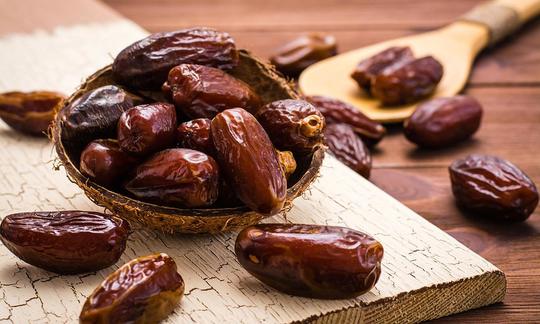

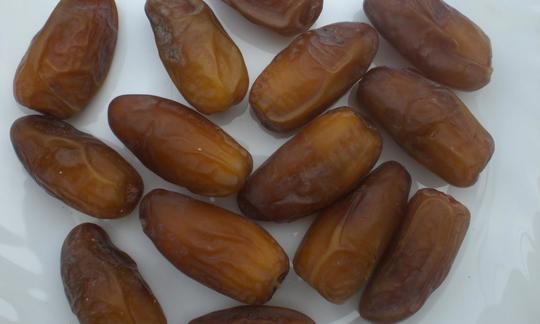

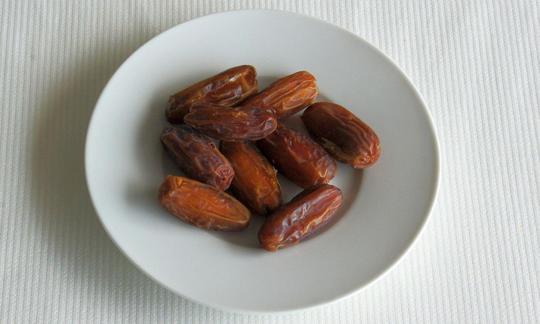

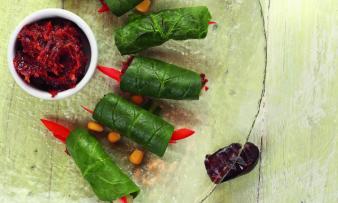
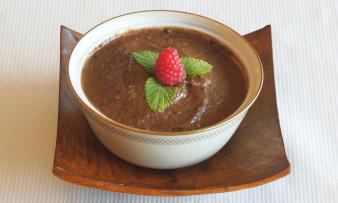






Comments